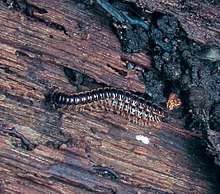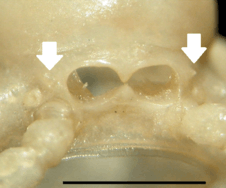Paradoxosomatidae
Paradoxosomatidae, the only family in the suborder Paradoxosomatidea (also known as Strongylosomatidea),[1] is a family of flat-backed millipedes in the order Polydesmida. Containing nearly 200 genera and 975 species as of 2013, it is one of the largest families of millipedes.[2] Paradoxosomatids occur on all continents except Antarctica, and can generally be distinguished by dorsal grooves on most body segments and a dumb-bell shaped gonopod aperture. Notable groups within the Paradoxosomatidae include the dragon millipedes of Southeast Asia, and the widely introduced Greenhouse Millipede Oxidus gracilis.[3]
| Paradoxosomatidae | |
|---|---|
.jpg) | |
| Asiomorpha coarctata | |
| Scientific classification | |
| Kingdom: | Animalia |
| Phylum: | Arthropoda |
| Class: | Diplopoda |
| Order: | Polydesmida |
| Suborder: | Paradoxosomatidea Daday, 1889 |
| Family: | Paradoxosomatidae Daday, 1889 |
| Diversity | |
| c. 200 genera, 975 species | |
| Synonyms | |
|
Strongylosomatidae Cook, 1895 | |
Description
The family is characterised by several traits. Most species possess a groove or furrow ("sulcus") on the dorsal surface between the keels (paranota) on each segment, and the keels of the second body segment are situated lower on the body than those of the first segment (collum) and third segment. In males, the opening on the underside of the body where the gonopods (male reproductive appendages) attach has a central constriction, forming the shape of an hourglass or dumb-bell. Males of most species also possess one or two projections on the sternite of the fifth body segment.[2][4] Paradoxosomatids may have 19 or 20 body segments in addition the head, and ozopores (defensive gland openings) situated on the lateral margins of keels on (in most species) segments 5, 7, 9, 10, 12, 13, and 15 to the last segment.[2]
Distribution
Paradoxosomatids occur on every continent except Antarctica, although the only species found in North America north of Mexico are introduced. The so-called greenhouse millipede, Oxidus gracilis likely native to Japan, occurs worldwide, often associated with greenhouses or agricultural settings. Widely introduced species in the tropics include Asiomorpha coarctata (native to Southeast Asia) and Chondromorpha xanthotricha, native to Sri Lanka or southern India.[2]
Classification



The nearly 1000 valid species of paradoxosomatids are divided into three subfamilies and 22 tribes. Most species (over 760) belong to the subfamily Paradoxosomatinae.[2]
Subfamily Alogolykinae - two tribes, around 60 species, central, south, and southeast Asia
- Alogolykini - Myanmar, China, Vietnam, Nepal
- Polydrepanini - Pakistan, India, Myanmar
Subfamily Australiosomatinae - three tribes, around 140 species, Southeast Asia and Oceania
- Antichiropodini - Australia, Indonesia
- Aschistodesmini - New Guinea
- Australiosomatini - Australia
Subfamily Paradoxosomatinae - 17 tribes, around 760 species, worldwide
- Catharosomatini - South America
- Centrodesmini - Indonesia
- Chamberliniini - Taiwan, Japan
- Cnemodesmini - Africa
- Eroonsomatini - Italy, Balkans
- Eustrongylosomatini - New Guinea, Philippines, Micronesia, Solomon Islands, Seychelles
- Eviulisomatini - Africa
- Graphisternini - Peru
- Nedyopodini - Taiwan, Southeast Asia
- Orthomorphini - Southeast Asia, some globally widespread
- Paradoxosomatini - Europe, middle East, Myanmar, China, India
- Sulciferini - Southeast Asia, some globally widespread species
- Sundaninini - Southeast Asia
- Tectoporini - Southeast Asia
- Tonkinosomatini - Indochina
- Xanthodesmini - Africa, Pakistan
Select taxa
- Antichiropus
- Chamberlinius
- Desmoxytes
- Desmoxytes purpurosea, the "shocking pink dragon millipede"
- Desmoxytoides
- Orthomorpha
References
- "Paradoxosomatidea Daday, 1889". Integrated Taxonomic Information System. Retrieved January 18, 2011.
- Nguyen, A. D., & Sierwald, P. (2013). "A worldwide catalog of the family Paradoxosomatidae Daday, 1889 (Diplopoda: Polydesmida)". CheckList. 9 (6): 1132–1353. Archived from the original on 2017-09-11. Retrieved 2014-09-26.CS1 maint: multiple names: authors list (link)
- McCormack, Gerald (2007). "Oxidus gracilis, Short-flange Millipede". Cook Islands Biodiversity Database, Version 2007.2. Cook Islands Natural Heritage Trust, Rarotonga. Retrieved 14 October 2013.
- J. Gordon Blower (1985). "Family Paradoxosomatidae". Millipedes: Keys and Notes for the Identification of the Species. Synopses of the British Fauna 35 (2nd ed.). Brill Publishers. p. 216. ISBN 978-90-04-07698-3.
External links

- Representative Photographs

